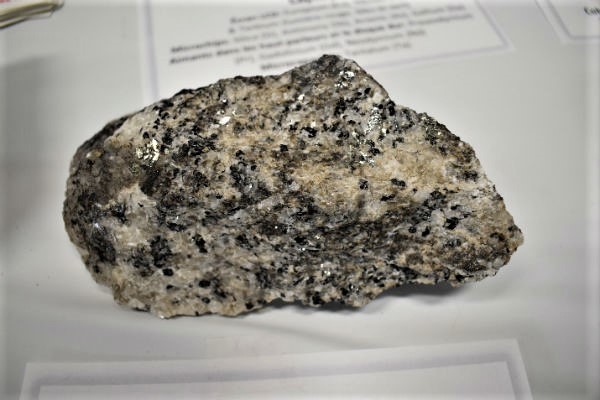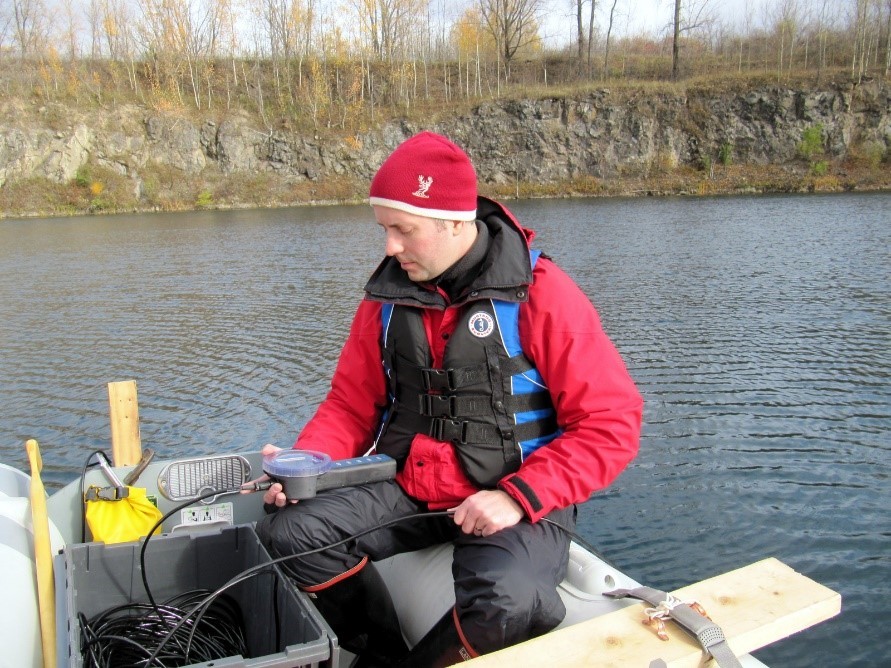Today’s cutting-edge technologies — from smart phones to zero-emission vehicles to life-saving medical equipment — are becoming a way of life as society relies on these devices and looks to reduce its carbon footprint. But have you ever wondered where our modern technology comes from? What you’re holding in your hand? What’s under the hood of your electric vehicle?
May 2021
By Dr. Michael Parsons, research scientist with the Geological Survey of Canada (GSC), Natural Resources Canada (NRCan)
Most of us probably spend more time looking at our phones and other electronic gadgets than we would care to admit. But for me, it’s part of my job. I’m not just surfing the web, or streaming videos. I’m also thinking about what’s inside these devices and how Canada can help to meet the ever-growing demand for these devices.
Michael Parsons with his exhibit at the 2017 Bedford Institute of Oceanography Open House in Dartmouth, NS. Smartphones are full of rare earth elements.
Knowing what raw materials phones are made of and understanding which elements are needed to build lower-carbon energy sources and rechargeable batteries — these questions are essential in order for Canada’s mining sector to operate in today’s environment. Many of these technologies require critical materials like rare earth elements, often sourced from overseas under challenging environmental and social conditions.
What are rare earth elements?
Aside from more familiar elements like nickel and copper, your cellphone and many new technologies also require various rare earth elements, or REEs. There are 17 different REEs with names most people have never heard of: dysprosium, thulium, yttrium and the others. These elements play an essential role in modern technology. The bright colours in our phone displays; the advanced medical imaging equipment used to diagnose diseases with greater speed and accuracy; the magnets that generate electricity in wind turbines; the batteries in the latest electric and hybrid cars — these are just a few of the many technologies that rely on the unique properties of REEs to make them work.
Despite their name, most REEs are relatively plentiful in the Earth’s crust — even more abundant than elements like gold or platinum. Rare earth elements occur in a wide range of different deposit types all around the world, but their chemical similarity makes it very difficult to separate REEs from one another. The 17 REEs are often included under the umbrella term “critical minerals,” which are materials that are essential for modern society but whose supply is at risk for various reasons: geological scarcity, political control of exports, low recycling rates or concerns over the environmental or social impacts of mining.
China is the world’s largest producer of REEs, accounting for roughly 60 percent of global annual production in 2020. However, many other countries are searching for new REE deposits and developing improved methods to extract REEs from the earth in a cost-effective way without harming the environment.

Carbonatite sample with niobium and rare earth elements from Oka, QC.
Canada’s opportunity
Canada has some of the largest known reserves and resources of REEs in the world, and many companies are working hard to bring new mines into production. In response to the rising global demand for these elements, the Government Canada released its first-ever list of critical minerals (including REEs) in March 2021 to help position Canada as a reliable source of these essential materials. These minerals are crucial for supporting our transition to a low-carbon, digital economy, and Canada is well-positioned to supply more of these resources, as described in the recent Canadian Minerals and Metals Plan.
While it’s important for us as individuals to move toward more environmentally friendly technologies, it’s also essential for all of us to better understand our electronic devices’ environmental footprint. It’s vital to find new ways to source critical minerals in a manner that minimizes impacts on the environment and local communities. And Canada can help do that.
As part of NRCan’s Environmental Geoscience Program, scientists from the Geological Survey of Canada (GSC) recently studied a former mine in Oka, Quebec, that contains REEs as well as its main deposit of niobium, a chemical element used in superconducting materials like those used in medical imaging equipment. The main goals of this research were to help predict potential environmental impacts at future REE mines across Canada and to guide management of mine wastes.

Michael Parsons measuring surface water quality in a flooded open pit at the former St. Lawrence Columbium Mine in Oka, QC.
Through their studies, scientists learned that in addition to REEs, the ore and mine wastes at this site are also enriched in uranium, thorium and fluoride. Metals and radionuclides — atoms that undergo radioactive decay — in the local bedrock and mine waste are relatively immobile in surface waters but may move freely in deep groundwaters. Runoff from the mine wastes contains low concentrations of uranium, REEs and other metals but high concentrations of fluoride and sulfate, which may pose a risk to aquatic life.
The results of these GSC studies complement other research underway at NRCan, including the CanmetMINING-led Canadian Rare Earth Element R&D Initiative and the GSC’s recently renewed Targeted Geoscience Initiative. Collectively, these research programs are helping to identify new sources of critical minerals across Canada, address key processing challenges and improve methods to mitigate the environmental impacts of mining.
This exciting field of research and development will provide the knowledge needed to make our minerals and metals sector more competitive, as well as help show that Canada is an environmentally responsible supplier of critical metals.
So the next time you look something up on your phone, start your electric vehicle, watch a show on your flat screen TV or go for a medical imaging appointment at the hospital, remember that none of this would be possible without REEs and other critical minerals.
For more information:
Explore:
More about Michael Parsons’ research on Science.gc.ca
Canada’s list of critical minerals
Canadian Minerals and Mining Interactive Map
Canadian Minerals and Metals Plan
Canadian Rare Earth Elements and Chromite Research and Development Program
Listen:
Why are rare earth elements important?
Watch:
Geoenvironmental Characteristics of Canadian Critical Metal Deposits